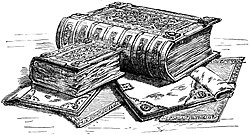Domesday Book
| Domesday Book | |
|---|---|
| The National Archives, Kew, London | |

Domesday Book: an engraving published in 1900. Great Domesday (the larger volume) and Little Domesday (the smaller volume), in their 1869 bindings, lying on their older "Tudor" bindings.
|
|
| Also known as | The Great Survey; Liber de Wintonia |
| Date | 1086 |
| Place of origin | England |
| Language(s) | Medieval Latin |
Domesday Book (/ˈduːmzdeɪ/ or US /ˈdoʊmzdeɪ/;Latin: Liber de Wintonia "Book of Winchester") is a manuscript record of the "Great Survey" of much of England and parts of Wales completed in 1086 by order of King William the Conqueror. The Anglo-Saxon Chronicle states:
Then, at the midwinter [1085], was the king in Glocester with his council ... . After this had the king a large meeting, and very deep consultation with his council, about this land; how it was occupied, and by what sort of men. Then sent he his men over all England into each shire; commissioning them to find out 'How many hundreds of hides were in the shire, what land the king himself had, and what stock upon the land; or, what dues he ought to have by the year from the shire.'
It was written in Medieval Latin, was highly abbreviated, and included some vernacular native terms without Latin equivalents. The survey's main purpose was to determine what taxes had been owed during the reign of King Edward the Confessor, which allowed William to reassert the rights of the Crown and assess where power lay after a wholesale redistribution of land following the Norman conquest.
The assessors' reckoning of a man's holdings and their values, as recorded in Domesday Book, was dispositive and without appeal. The name "Domesday Book" (Middle English for "Doomsday Book") came into use in the 12th century. As Richard FitzNeal wrote in the Dialogus de Scaccario (circa 1179):
...
Wikipedia
